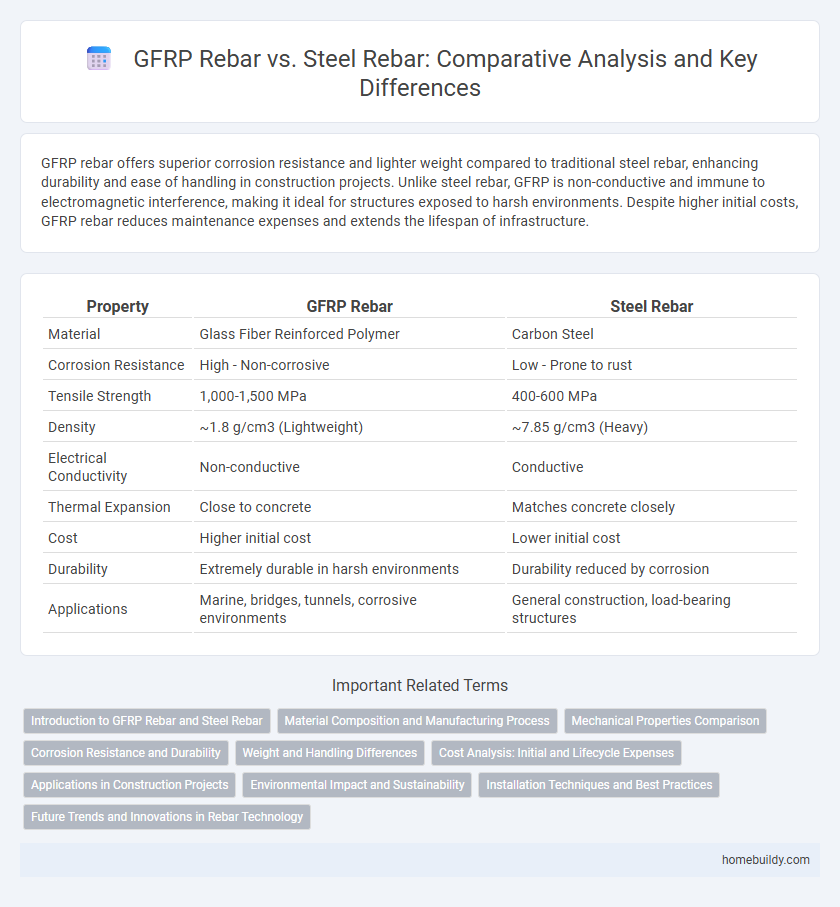GFRP rebar offers superior corrosion resistance and lighter weight compared to traditional steel rebar, enhancing durability and ease of handling in construction projects. Unlike steel rebar, GFRP is non-conductive and immune to electromagnetic interference, making it ideal for structures exposed to harsh environments. Despite higher initial costs, GFRP rebar reduces maintenance expenses and extends the lifespan of infrastructure.
Table of Comparison
| Property | GFRP Rebar | Steel Rebar |
|---|---|---|
| Material | Glass Fiber Reinforced Polymer | Carbon Steel |
| Corrosion Resistance | High - Non-corrosive | Low - Prone to rust |
| Tensile Strength | 1,000-1,500 MPa | 400-600 MPa |
| Density | ~1.8 g/cm3 (Lightweight) | ~7.85 g/cm3 (Heavy) |
| Electrical Conductivity | Non-conductive | Conductive |
| Thermal Expansion | Close to concrete | Matches concrete closely |
| Cost | Higher initial cost | Lower initial cost |
| Durability | Extremely durable in harsh environments | Durability reduced by corrosion |
| Applications | Marine, bridges, tunnels, corrosive environments | General construction, load-bearing structures |
Introduction to GFRP Rebar and Steel Rebar
GFRP rebar, made from glass fiber reinforced polymer, offers high corrosion resistance and lightweight properties compared to traditional steel rebar. Steel rebar provides superior tensile strength and ductility, making it essential in concrete reinforcement for structural integrity. Both materials serve critical roles in construction, with GFRP favored for durability in corrosive environments and steel preferred for maximum load-bearing applications.
Material Composition and Manufacturing Process
GFRP rebar is composed of glass fibers embedded in a polymer matrix, typically vinyl ester or epoxy resin, which provides high corrosion resistance and lightweight properties. Steel rebar consists primarily of carbon steel with varying alloying elements, produced through hot rolling and surface deformations for enhanced bonding with concrete. The manufacturing of GFRP involves pultrusion or extrusion processes, resulting in non-metallic reinforcement with superior durability, while steel rebar undergoes casting and mechanical treatment to achieve strength and ductility.
Mechanical Properties Comparison
GFRP rebar exhibits higher tensile strength, often exceeding 1,000 MPa, compared to steel rebar's typical range of 400-600 MPa, making it ideal for applications requiring lightweight yet strong reinforcement. Its low modulus of elasticity, approximately 40-60 GPa versus steel's 200 GPa, results in higher elongation and flexibility but lower stiffness, influencing deflection behavior in concrete structures. Corrosion resistance of GFRP rebar significantly outperforms steel, enhancing durability in harsh environments without compromising mechanical integrity over time.
Corrosion Resistance and Durability
GFRP rebar offers superior corrosion resistance compared to steel rebar, as it is immune to rust and chemical degradation in harsh environments such as marine or chloride-rich concrete applications. The durability of GFRP rebar significantly extends the service life of concrete structures by eliminating corrosion-induced cracking and spalling commonly observed with steel reinforcement. This enhanced longevity reduces maintenance costs and ensures structural integrity in corrosive settings where steel rebar typically deteriorates.
Weight and Handling Differences
GFRP rebar weighs approximately 70-80% less than steel rebar, significantly reducing overall structural weight and easing transportation and installation. Its lightweight nature enhances handling safety and efficiency on construction sites, minimizing labor fatigue and equipment requirements. Steel rebar's higher density leads to increased weight, complicating logistics and handling compared to GFRP alternatives.
Cost Analysis: Initial and Lifecycle Expenses
GFRP rebar typically incurs higher initial costs than steel rebar due to advanced manufacturing processes and materials but offers significant savings in lifecycle expenses by resisting corrosion, reducing maintenance and replacement needs. Steel rebar, while less expensive upfront, can lead to increased long-term costs, especially in corrosive environments where rust compromises structural integrity and necessitates frequent repairs. Evaluating total cost of ownership, GFRP rebar provides economic advantages in durability-sensitive projects such as marine, bridge, and infrastructure construction.
Applications in Construction Projects
GFRP rebar is increasingly preferred in construction projects requiring corrosion resistance, such as marine structures, bridges, and wastewater treatment plants. Steel rebar remains dominant in high-load applications like skyscrapers and heavy infrastructure due to its superior tensile strength and ductility. The choice between GFRP and steel rebar depends on environmental conditions, structural requirements, and lifecycle cost considerations.
Environmental Impact and Sustainability
GFRP rebar offers significant environmental benefits over steel rebar due to its non-corrosive nature, which extends structure lifespan and reduces maintenance-related emissions. The production of GFRP rebar consumes less energy and produces fewer greenhouse gases compared to steel rebar manufacturing, contributing to lower carbon footprints in construction projects. Sustainable construction practices increasingly favor GFRP rebar for its recyclability and ability to minimize resource depletion, aligning with global goals to reduce environmental impact.
Installation Techniques and Best Practices
GFRP rebar requires specialized cutting tools such as diamond blades or abrasive wheels, while steel rebar can be cut using conventional metal cutting equipment, making GFRP more labor-intensive during installation. Proper alignment and anchorage for GFRP rebar demand adherence to manufacturer specifications due to its lower modulus of elasticity and brittle nature, contrasting with steel's ductility and flexibility. Best practices for both materials include ensuring corrosion protection, but GFRP rebar excels in environments prone to chemical exposure, reducing the need for additional coatings or treatments compared to steel rebar.
Future Trends and Innovations in Rebar Technology
GFRP rebar is gaining traction as a corrosion-resistant alternative to traditional steel rebar, especially in infrastructure exposed to harsh environments. Innovations in manufacturing processes are reducing costs and enhancing the tensile strength and durability of GFRP composites. Future trends emphasize integrating smart sensors into rebar for real-time structural health monitoring, driving advancements in sustainable and resilient construction materials.
GFRP Rebar vs Steel Rebar Infographic

 homebuildy.com
homebuildy.com